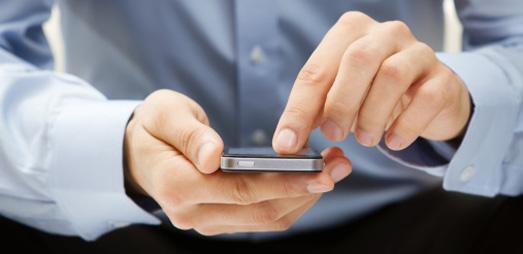Ergonomists have been expecting it for years. In fact, we’re frankly quite shocked that it’s taken so long for the concerns to surface. Reports have associated smartphone use with de Quervain’s tenosynovitis and osteoarthritis. Research done at the University of Waterloo (UW) shows that heavy users of portable mobile devices report thumb, shoulder, and neck pain. The smartphone has become ubiquitous; 98% of the UW survey, involving university staff, students, and faculty, used a mobile device. About half of those experienced moderate to severe pain in their thumbs, neck, or shoulders. In fact, 15 percent of them experienced “severe” pain (7 or more on a 10-point scale). More importantly, the study showed that the more you use a portable mobile device, the more discomfort you’ll experience. Participants who used their devices for more than 2 hours and 22 minutes a day were 3.5 times more likely to report moderate to severe thumb discomfort.
Of course, employers don’t have control over smartphone use outside of work, and so this will ultimately raise issues regarding compensability of these injuries. What are people doing on their smartphones? UW’s study indicated that users reported that they spent, on average, the following amounts of time using information and communication technology:
- Computer/laptop: 8 hours, 14 minutes
- Internet browsing*: 2 hours, 14 minutes
- Music/videos/taking pics*: 2 hours, 8 minutes
- Gaming on smartphone*: 1 hour, 17 minutes
- Game controller: 1 hour, 11 minutes
- Email, texting, and messaging*: 1 hour, 2 minutes
- Telephone*: 58 minutes
- Scheduling*: 19 minutes
* Note that some of these activities were simultaneous, as the reported average for total time using a portable mobile device was 4 hours, 39 minutes.
Teenagers don’t seem to complain as much as adults…an article in US News reported that the “itises” don’t seem to show up until the 40s or 50s. Of course, most “adults” can probably identify how our current “itises” relate back to activities or injuries that we sustained as teens….projecting forward a few decades, this doesn’t bode well for the “adults” of the 2040s! Add to that the current trend toward inactivity and obesity, and we’ve got some serious problems ahead!
Tablets seem like an attractive alternative….bigger hand movements on the larger screen are less “cramped” and perhaps less repetitive for the thumbs. However, the neck posture while holding a tablet is really no better than while holding a smartphone, and the weight of the tablet, although light, still must be supported somehow. Reading a recipe or watching videos on a propped up iPad is not so bad, but playing games on the touch screen is only marginally better than playing games on the smaller iPod. So how will this story progress….what is the “solution”? Well, there are a few things we can do:
- Limit usage. “What? Are you kidding me?” I can almost hear your teenager (and mine) wailing. Sometimes we just need to be reminded that fresh air, the oldest of all sources of entertainment, is really also the best. This would also help to resolve our obesity issues. And really, when it comes to social media use, can anyone really argue that it’s more efficient or effective to text than to talk?
- Do more on your computer. The keyboard and traditional display screen have their limitations, but by and large the computer offers a better hand/arm/ neck interface than the tiny personal mobile device.
- Encourage an optimal texting posture. A study by Gustafsson et al. (2011) showed that texting with two thumbs, with the back and forearms supported, were less likely to be “symptomatic” than those who texted with one thumb, or sat with the neck and back bent forward.
- Stretch. Every once in a while, open your hand wide, rotate your thumbs in big circles, clench and release your fists. Stretch your neck by tilting ear to shoulder and circling your head from side to side (not back). Stretch your shoulders by reaching up, and circling your arms. It’s really a bit late, by the time you feel tension in your muscles and joints, but, as they say, “Better late than never.” (Call us for pricing on our stretching posters!)
Surely, ergonomists somewhere must be toiling away to ensure that the next generation of smartphones is likely to address these issues, and we are anxious to see how the user will view the screen with the head balanced over the shoulders, and enter text with the hands and wrists in a neutral position. Already, some devices provide options to allow a variety of postures to be used to control the devices (i.e. keyboard AND touch screen) In the next smartphones… how will the interface with the hand become more “neutral”? How will the devices project a display into a space where it can be seen with neutral neck and shoulders? Maybe people will learn a new syntax to reduce how much they have to type? Will language recognition progress to allow us to enter sentences without typing out full words? Is a stylus better than a keyboard?…..stay tuned….


